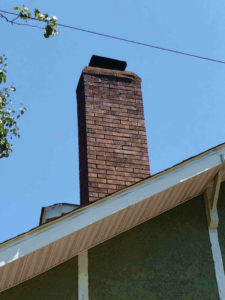Is the winter chill finding its way into your home, even when you have all of your doors and windows shut tight? Cold air could be finding a way into your home through a damaged chimney damper. Here’s what you need to know about chimney dampers and the unwanted chills, and what you can do about a damaged chimney damper.
Chimney dampers and cold drafts
 A chimney damper’s primary role is to keep things from entering your home, and that includes cold air. Most chimney dampers are located within the throat of the chimney, above the firebox. They feature a metal ring around the circumference of the chimney opening, and a metal flap covers the opening.
A chimney damper’s primary role is to keep things from entering your home, and that includes cold air. Most chimney dampers are located within the throat of the chimney, above the firebox. They feature a metal ring around the circumference of the chimney opening, and a metal flap covers the opening.
When a fire is burning in the fireplace, you open the damper to let smoke escape. When your fireplace isn’t in use, the damper needs to be in the closed position to create a barrier between your home and the chimney. An open chimney damper is essentially an open window to your home. If you leave it open, or if it’s damaged, you will lose the warm air from your home out of your chimney, and you will feel cold drafts in your home as they blow down your chimney.
Chimney damper damage
Chimney dampers deal with a lot of abuse. Because of its location, chimney dampers can warp or crack due to the extreme heat of the fireplace. Most chimney dampers are metal, so they tend to rust or deteriorate when water or moisture finds its way into your chimney. When chimney dampers are damaged, this can cause your damper to get stuck in either the opened or closed position.
When dampers are stuck in the closed position, this inhibits the use of your fireplace. However, when dampers are stuck in the opened position, this lets hot air out and cold air into your home. Even if the damper still opens and closes, a bad seal when the damper is closed allows air to leak around the chimney, which chills your home in the winter.
Dealing with a damaged damper
The only solution for a damaged chimney damper is to replace it. In most cases, chimney sweeps recommend replacing a failing throat damper with a top-sealing chimney damper. A top-sealing damper is installed at the top of your chimney flue. The primary benefit of top-sealing dampers is that they feature a rubber gasket that allows for a complete seal when the damper is closed. With a top-sealing damper, cold air and moisture can’t get into your chimney, and warm air can’t escape your home.
If your failing chimney damper is causing a chill in your home this winter, call Total Chimney Care! We can outfit your chimney with a new damper that will open and close smoothly and block air exchange through your chimney!

